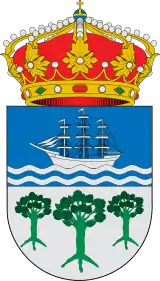Foz
Foz[1] (Galician pronunciation: [fɔθ]) is a town and municipality in A Mariña country in the Galician province of Lugo. It has been historically linked to the Ancient Province of Mondoñedo and also linked to the arrival of Briton immigrants during the Dark Ages (5th and 6th centuries) fleeing by sea from the British Isles (see Bishop Maeloc, Britonia and San Martiño de Mondoñedo) It has 9800 inhabitants. It borders the municipalities of Burela and Barreiros, and to interior with the municipalities of Lourenzá, Mondoñedo, O Valadouro, Alfoz and Cervo.
.jpg.webp)

Foz is a coastal town on the shores of the Cantabrian Sea at the mouth of the river Masma, where it forms the Foz estuary, with an approximate area of 100 km².
Although Foz was previously a fishing village, now the major part of its economic resources is from tourism.

Etymology
The name Foz comes from the Latin word faux[2] which graphically describes the river mouth of the Masma river; Foz is the Galician term for base level.
History
The foundation of Foz dates back to pre-Roman times, as attested by the existing forts Fazouro and Pena do Altar. Its foundation may originate in the time of the Ártabros or, according to the historian Amor Meilán, a factory may have been established by the Tartessos.
During the ninth century the town had flourished since the establishment of the episcopal headquarters in San Martiño de Mondoñedo.
At the time of Ferdinand and Isabella, Foz kept certain privileges and exemptions as a result of its commercial importance.
During the sixteenth and seventeenth Foz had a major port and one of the three most important shipyards in Galicia. Owners and Phoenician fishermen engaged mainly to whaling. Shipowners and Phoenician fishermen dedicated themselves mainly to whaling. This important fishery was declining over time, but today is an important seafaring tradition.
The main monuments of Foz are the Basilica de San Martiño and the Manor of the Counts of Fontao
Port of Foz
 Fishing port
Fishing port Sport port
Sport port
